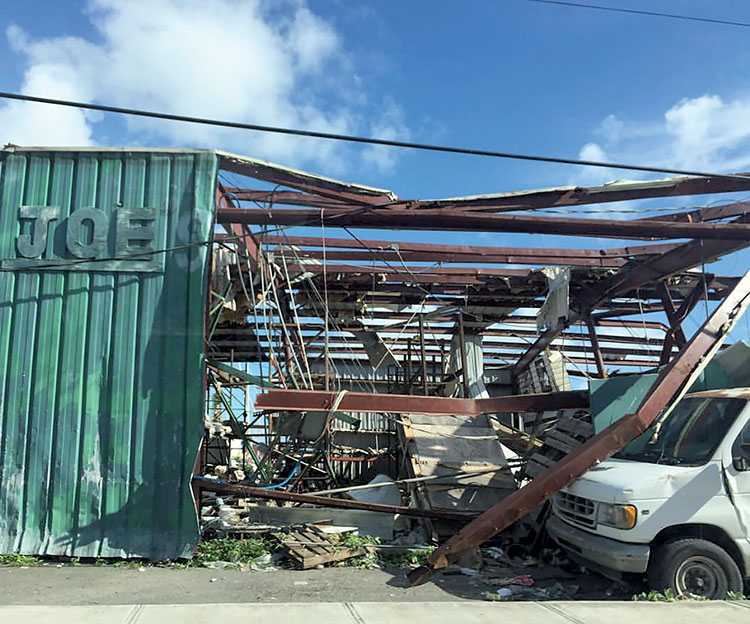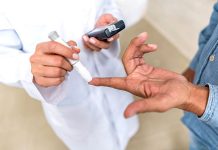By John Burton |
HOLMDEL – It might have meant losing some hard-earned and much-needed vacation time, but for three emergency department nurses, and for those who were receiving the help, it was well worth it.
“Nurses help people. What it comes down to is helping,” said Alexis Papiomitis, a registered nurse working in Bayshore Community Hospital’s Emergency Department, about her and her colleagues’ recent experiences in St. Thomas in the Caribbean.
Papiomitis, a Jackson resident, joined fellow RNs from Bayshore’s Emergency Department Amelia Martin, Somerset, and Laura Ortiz-Bernal, who also lives in Jackson, as they spent 15 days in St. Thomas, in the U.S. Virgin Islands, offering their assistance in the aftermath of the one-two punch of Hurricanes Irma and Maria. Ortiz-Bernal also spent nearly a week providing help to Haiti as that island nation struggled to recover from the storm’s effects.
The nurses responded to a request made by the New Jersey Hospital Association looking for volunteers who have emergency department and intensive care unit experience who would be willing to lend a helping hand, explained Regina Foley, chief operating officer at Bayshore. The nurses did not receive compensation and had to use available vacation time for the excursion, according to Foley.
With the support of their department manager, who assured the three women their shifts would be covered, the three decided to head to the island to help.
The role the visiting health care providers would serve would be “to give that community a break,” said Foley. The staff at the Roy Lester Schneider Regional Medical Center in St. Thomas was “working 24/7,” Papiomitis said, becoming increasingly exhausted as they grappled to address the island’s medical needs.
“The nurses there were very overworked,” remembered Ortiz-Bernal.
The three joined seven other nurses from New Jersey and U.S. Army doctors from Fort Bragg, North Carolina, working at the medical facility; all of whom, along with other U.S. Army personnel and U.S. National Guardsmen, found themselves living on a Federal Emergency Management Agency (FEMA) ship just off shore and working 12-hour shifts at the medical center.
“We had no idea what we were getting ourselves into,” Ortiz-Bernal said.

The islands had experienced extensive damage, and even by November, a considerable time since the storms first struck, there were buildings barely standing, ravaged by the effects; there were piles upon piles of debris marking the streets and Papiomitis noted that about 70 percent of the island was still without electricity.
“I didn’t see one building that wasn’t hit, really,” she said.
And that included, the medical center. Much of the Schneider facility was damaged and closed, leaving just 17 beds out of the usual approximately 120 available to in-patients, with patients resting on gurneys in the emergency area and hallways, subsisting on U.S. military-issued MREs (Meals, Ready-to-Eat).
The medical center also had to accommodate patients from the neighboring islands, as other facilities were mostly unable to operate from the storm damage.
Patients often found themselves waiting up to nine hours to see a doctor, even as Army doctors operated a “fast-track” treatment service, hoping to get easily treated, relatively minor complaints cared for more efficiently.
The Schneider medical center functioned with the use of generators. However, there were still equipment problems and shortages. That caused dialysis patients to need to be transported to Miami or Atlanta for treatment three times a week, they said. And there was a shortage of medication some of the time, and on other occasions the nurses would have to run their own lab work, when technicians weren’t available.
The nurses saw what any emergency room might see: patients with complications from diabetes, hypertension and other chronic conditions. But they also had to address the population’s sickle cell disease, a common condition there. There were the after-effects of violent confrontations, with the nurses having to treat knife wounds.
Another common ailment in the region is ciguatera, a type of food poison carried by fish – on an island where fish is a food staple.
“We’re not trauma nurses,” Ortiz-Bernal acknowledged, “but you kind of learn.”
And one thing you definitely learn, Martin said, “Expect the unexpected.”
Despite the long hours, limited resources, the three women said it was a learning and growing experience, not in least because of the gratitude expressed by the patients and their loved ones on the island. “They were so appreciative,” Papiomitis said.
“People were very positive, very optimistic,” Martin said.
Foley, who is also a nurse in addition to being the Bayshore COO, did not accompany her three nurses on this mission; but each year she volunteers her time with the Catholic Medical Mission Board, traveling to Haiti to offer different specialized treatments each year. “Once you get the bug,” from volunteering, Foley said, “you’ll seek out the opportunity.
“What you gain from this is life changing.”
Papiomitis advised anyone thinking of volunteering, “Do it. It’s worth it,” adding, “for the patients and the staff.”
This article was first published in the Dec. 7-14, 2017 print edition of the Two River Times.














